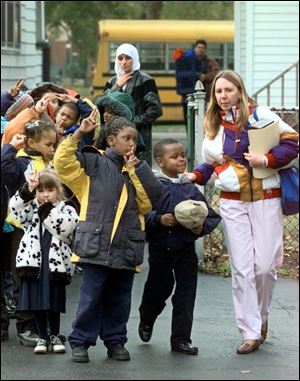
A passing grade for school vouchers?
2/20/2005
First graders at Hope Tremont Academy, one of Cleveland's voucher schools, and their teacher return from a field trip in 1998. Earlier this month, Gov. Bob Taft proposed expanding the voucher program to the entire state.
COLUMBUS - Christine Suma and her husband have 12 children, and five have tapped state tax dollars to go to private school in Cleveland.
Mrs. Suma said she supports Gov. Bob Taft's proposal to expand the school voucher program to K-8 students around Ohio, including Toledo.
"It will educate a group of children who otherwise would not have access to a good education," said Mrs. Suma, who lives on the west side of Cleveland.
But researchers at Indiana University have found that the impact of the voucher program on student achievement in Cleveland remains unclear after nine years.
This school year, the state is using about $12 million in tax dollars to help 5,623 students from low-income families in Cleveland attend private schools. The voucher is up to $2,700 for students in ninth and tenth grade, and up to $3,000 for K-8.
"Certainly, [voucher] students' achievement is at least as high as it would be expected to have been had they enrolled in public schools," said the lead researcher, Kim Metcalf, who works for the county school system in Bloomington, Ind.
"There is also some evidence of benefits in some subjects and at some points in time, but these benefits are not consistent," he added.
Under a $4.1 million contract with the state, the IU Center for Research on Learning and Technology has released annual reports since 1998 on the Cleveland voucher program.
The 2004 report found that students who had used a voucher in kindergarten achieved at much higher levels on math, reading, and overall tests than a similar group of students in the Cleveland Municipal School District.
But by the end of second grade, voucher students outperformed only public school students whose families did not apply for vouchers - and only in reading and overall test scores.
Voucher students did better in reading and on tests covering several subjects in third and fourth grades, but their performance is "roughly equivalent" to students whose families applied for vouchers but did not get them in all other topics and grades, Mr. Metcalf said.
By the end of fifth grade, there were no differences on a standardized test in five of the six topics between voucher and public school students.
The reasons for these ups and downs are unclear, Mr. Metcalf said.
"It does seem very strange. I would have predicted a few years ago that at the end of fifth grade, voucher students would have expanded their advantage over nonvoucher students," he said.
Researchers have speculated that the emphasis on preparing for the proficiency tests may be a factor, he said.
Teachers' unions and public school supporters have used the IU research to slam Mr. Taft's plan to expand the program to K-8 public school buildings where at least two-thirds of students do not pass the reading and math proficiency tests for three consecutive years.
If the program were in place now, students at 70 school buildings around Ohio would be eligible, including six Toledo elementary schools: Cherry, Glenwood, Hale, Lagrange, Pickett, and Warren.
The state is budgeting enough money for the 2006-2007 school year for 2,600 students around Ohio to get vouchers on a first-come, first-serve basis. They could pick private schools that volunteer for the program, which in Cleveland primarily has meant parochial schools.
"Any educationally sound rationale for Taft's voucher proposal is hard to find since the state's pilot voucher program proved unsuccessful in raising achievement," said Tom Mooney, president of the Ohio Federation of Teachers.
Susan Bodary, executive assistant to the governor for education and work force, said the IU research is "very good," but it's not the foundation for Mr. Taft's support for expanding the voucher program.
Mr. Taft is concerned about "pockets" within big-city school districts where children in early grades are making "little or no progress," she said.
"We want those families to have a choice of a better option," said Ms. Bodary. "We also want to provide an incentive for that school building to redouble its efforts for the kids who remain in it."
Jim Carl, an associate professor of education at Cleveland State University, predicted it will be "very difficult" to prove that a voucher program leads to higher academic achievement.
Instead of research on academic achievement, voucher programs could be defended as "giving a little help to the deserving poor," he said.
"The undeserving poor are parents who are not interested in their kids' education and are negligent. The deserving poor are those who are trying their best in modest cirumstances," Mr. Carl said.
Mrs. Suma, said she knew vouchers weren't a guarantee that her children would do well in school.
"Can every child get an 'A'? No. Can all children with handicaps learn to read? No. But can you have a parent make a choice where their child goes to school and can that parent say, 'I am satisfied or not satisfied?' Yes," she said.
Contact James Drew at: jdrew@theblade.com or 614-221-0496.